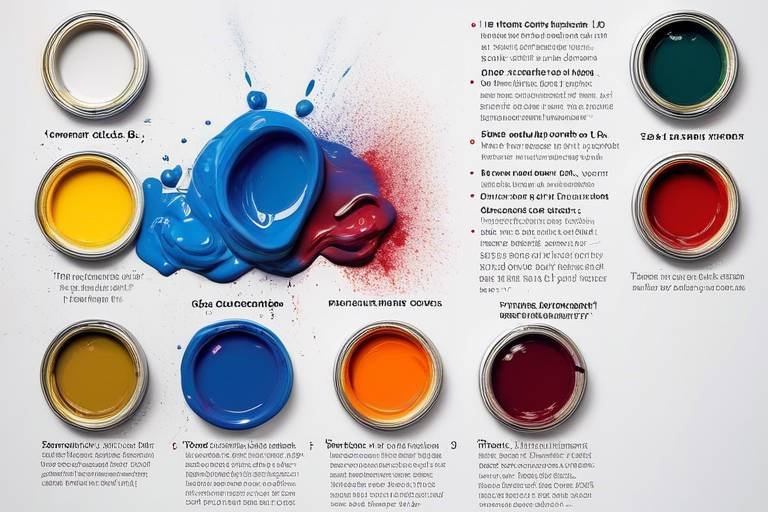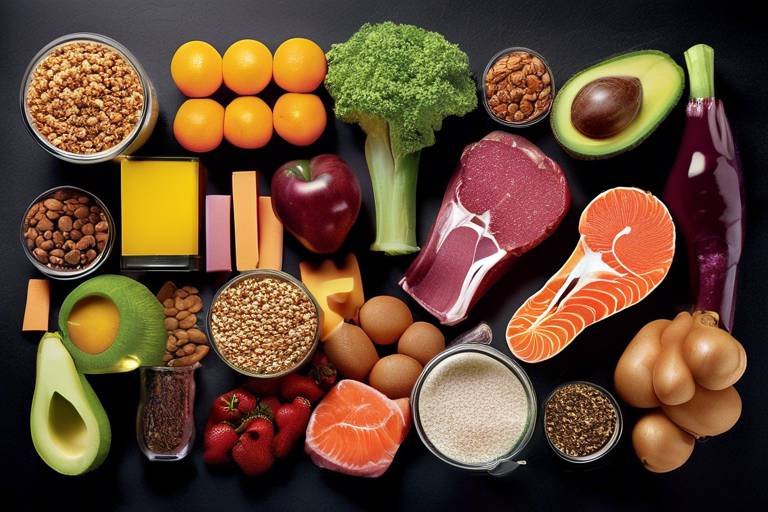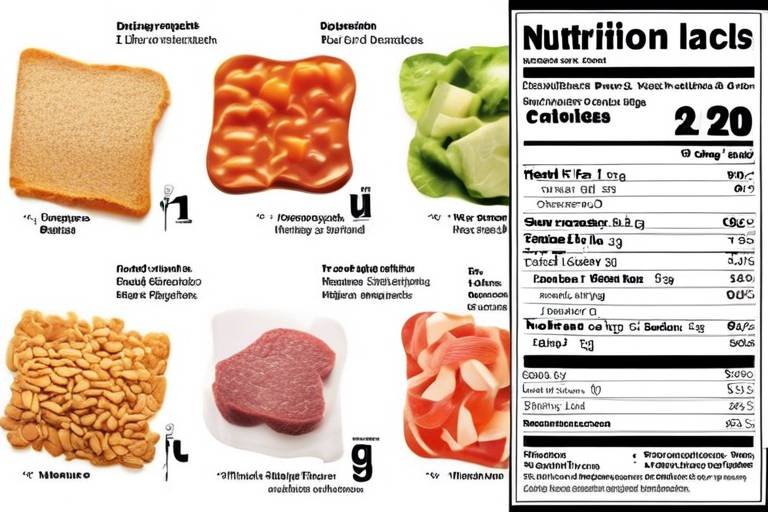The Chemistry of Paint - Understanding Colors and Finishes
Paint is more than just a decorative layer on walls; it’s a complex blend of chemistry that brings color and life to our surroundings. In this article, we will dive deep into the fascinating world of paint, exploring how colors are created, the role of finishes, and the intricate chemical processes involved in paint formulation and application. Whether you're a DIY enthusiast, a professional painter, or simply someone who loves the beauty of a freshly painted room, understanding the chemistry of paint can enhance your appreciation for this art form. So, let’s roll up our sleeves and get into the nitty-gritty of paint chemistry!
Color theory is fundamental in art and design, explaining how colors interact, complement, and contrast. It provides the basis for creating harmonious palettes and understanding the emotional impact of different hues. Have you ever noticed how a bright yellow can evoke feelings of happiness, while a deep blue might bring a sense of calm? This is no coincidence! Color theory helps us decode these emotional responses, making it an essential tool for artists and designers alike.
Pigments are the key components that give paint its color. They are tiny particles that absorb certain wavelengths of light while reflecting others, which is what our eyes perceive as color. There are various types of pigments used in paint, each with unique properties that affect the final appearance and durability of the paint. The choice of pigment can influence everything from the vibrancy of the color to its resistance against fading over time.
When it comes to pigments, there are two main categories: natural and synthetic. Natural pigments are derived from minerals and plants, offering a rich, organic quality. On the other hand, synthetic pigments are chemically manufactured, providing a wider range of vibrant colors and greater consistency. Each type has its pros and cons, affecting aspects like color vibrancy, stability, and environmental impact. For instance, while natural pigments may have a more muted tone, they can also be more eco-friendly, making them a popular choice for sustainable art practices.
With growing environmental concerns, eco-friendly pigments are gaining popularity among both artists and manufacturers. These pigments are made from sustainable sources and often contain fewer harmful chemicals. The benefits of using eco-friendly pigments include:
- Reduced environmental impact
- Improved indoor air quality
- Non-toxic properties, making them safer for children and pets
As more people become aware of their carbon footprint, eco-friendly pigments are paving the way for sustainable painting practices.
When selecting paint, two critical factors to consider are colorfastness and lightfastness. Colorfastness refers to a pigment's ability to retain its color over time, while lightfastness measures its resistance to fading under light exposure. Both properties are crucial for ensuring the longevity of painted surfaces. Imagine investing time and money into a beautiful mural, only to have it fade away in a few months due to sunlight exposure! Understanding these concepts can help you make informed choices when selecting paint for your projects.
Mixing and blending colors is an art in itself. Whether you’re painting a canvas or a wall, knowing how to achieve the desired hues and shades can make all the difference. The science behind color mixing involves understanding primary, secondary, and tertiary colors. For instance, mixing equal parts of blue and yellow gives you green, but varying the proportions can yield different shades. This process is akin to cooking; just as a pinch of salt can enhance a dish, the right mix of colors can elevate your artwork or home decor.
The finish of a paint affects its texture, sheen, and durability. Different finishes can dramatically alter the appearance of a surface, influencing everything from how light interacts with the paint to how easy it is to clean. In this section, we’ll examine various types of finishes, their applications, and how they contribute to the overall aesthetic of a painted surface.
When it comes to choosing a finish, the decision often boils down to matte versus gloss. Matte finishes provide a non-reflective surface, making them ideal for hiding imperfections and creating a soft, sophisticated look. Conversely, gloss finishes offer shine and durability, making them perfect for high-traffic areas or surfaces that require frequent cleaning. The choice between these two finishes can significantly impact the look and feel of a space.
Different finishes require varying levels of maintenance and care. For instance, while matte finishes may be easier to apply, they often require more frequent touch-ups. Gloss finishes, while durable, can show fingerprints and smudges more readily. Understanding these differences can help you choose the right finish based on the intended use and longevity desired for painted surfaces. It’s all about finding the right balance between aesthetics and practicality!
1. What are the main components of paint?
Paint typically consists of pigments, binders, solvents, and additives. Each component plays a crucial role in the paint's overall performance and appearance.
2. How do I choose the right paint finish?
Consider the room's function and the desired aesthetic. For high-traffic areas, a gloss finish may be more suitable, while a matte finish could work well in a bedroom.
3. Are eco-friendly paints as durable as traditional paints?
Yes, many eco-friendly paints offer excellent durability and performance, often matching or exceeding that of traditional paints.

Understanding Color Theory
Color theory is not just a set of rules; it’s a vibrant language that artists, designers, and even marketers use to communicate emotions and ideas. Think of it as the foundation of visual creativity, where every hue tells a story. When you mix colors, you're not just creating a palette; you're crafting a mood. For instance, warm colors like reds and yellows can evoke feelings of energy and warmth, while cool colors such as blues and greens often bring about calmness and tranquility. This emotional impact is why understanding color theory is essential for anyone involved in creative fields.
At its core, color theory revolves around the color wheel, a circular diagram that represents the relationships between colors. The primary colors—red, blue, and yellow—are the building blocks of all other colors. By mixing these primary colors, you can create secondary colors like green, orange, and purple, which in turn can be mixed to form tertiary colors. This wheel isn’t just a tool for artists; it’s a guide that helps in achieving harmony and balance in any design project.
One of the most fascinating aspects of color theory is the concept of complementary colors. Complementary colors are pairs that, when combined, cancel each other out, resulting in a grayscale color. Placing complementary colors next to each other creates a striking contrast that can make designs pop. For example, if you pair a vibrant orange with a deep blue, the result is a visual feast that draws the eye. This principle is widely used in branding and advertising to attract attention and convey messages effectively.
Moreover, color theory also delves into the psychological effects of colors. Each color can elicit specific emotions and associations, which can significantly influence consumer behavior. For instance, green is often associated with nature and tranquility, making it a popular choice for brands that want to convey sustainability. On the other hand, red can evoke excitement and urgency, which is why it’s frequently used in sales and promotions. Understanding these associations allows designers to strategically choose colors that resonate with their target audience.
In addition to emotional and psychological implications, color theory also addresses the temperature of colors. Colors can be classified as warm or cool, which affects the overall feel of a space or design. Warm colors tend to advance and create a sense of coziness, while cool colors recede, making spaces feel larger and more open. This is particularly important in interior design, where the right color temperature can transform an environment.
| Color | Emotion | Usage |
|---|---|---|
| Red | Excitement, Passion | Sales, Promotions |
| Blue | Calm, Trust | Corporate Branding |
| Green | Nature, Tranquility | Sustainability, Health |
| Yellow | Happiness, Energy | Child Products, Food |
In conclusion, understanding color theory is akin to mastering a powerful tool that can enhance creativity and communication. Whether you’re painting a canvas, designing a website, or branding a product, the principles of color theory will guide you in making informed decisions that resonate with your audience. So the next time you pick up a brush or sit down at your computer, remember that the colors you choose have the power to influence emotions and perceptions.
- What is color theory? Color theory is a set of principles used to understand how colors interact, complement, and contrast with one another.
- Why is color theory important? It helps in creating harmonious designs and understanding the emotional impact of colors on viewers.
- What are complementary colors? Complementary colors are pairs of colors that, when combined, cancel each other out and create a grayscale color.
- How do colors affect emotions? Different colors can evoke specific emotions, influencing consumer behavior and design choices.

The Role of Pigments
Pigments are the unsung heroes of the painting world, acting as the crucial elements that give paint its vibrant colors. Without pigments, paint would be nothing more than a bland, colorless substance. They are finely ground particles that can be derived from various sources, and they play a significant role in determining not only the color but also the appearance and durability of the paint. Understanding the types of pigments and their properties is essential for anyone looking to create stunning artwork or achieve a specific aesthetic in their space.
There are two primary categories of pigments: natural and synthetic. Natural pigments are sourced from minerals, plants, and even animals. For example, ochre, a natural pigment, comes from clay and iron oxide, providing earthy tones that have been used since prehistoric times. On the other hand, synthetic pigments are chemically manufactured, offering a wider range of colors and greater consistency. They often exhibit enhanced properties, such as improved colorfastness and stability, making them a popular choice in modern paint formulations. However, the choice between natural and synthetic pigments can influence not just the color but also the environmental impact of the paint.
Natural pigments have a certain charm and authenticity that many artists cherish. They often provide a unique depth of color that can be hard to replicate. However, they may lack the vibrancy and stability that synthetic pigments can offer. For instance, while a natural green pigment from plants may fade over time, synthetic greens can maintain their brilliance even under harsh conditions. This leads us to consider the eco-friendly pigments that have emerged in recent years. As environmental concerns grow, many manufacturers are turning to sustainable sources for their pigments, allowing artists to create beautiful works without compromising their values.
Eco-friendly pigments are derived from sustainable resources and are often non-toxic, making them a fantastic choice for environmentally conscious painters. These pigments not only reduce the ecological footprint but also contribute to healthier indoor air quality. For example, many brands now offer paints made with plant-based pigments or recycled materials, allowing consumers to make choices that align with their values. The rise of these eco-friendly options reflects a broader shift in the industry towards sustainability, demonstrating that you can achieve stunning results while being kind to the planet.
When selecting pigments, it's essential to consider two critical properties: colorfastness and lightfastness. Colorfastness refers to a pigment's ability to retain its color over time, even when exposed to various environmental factors. Lightfastness, on the other hand, measures how well a pigment can resist fading when subjected to light exposure. For artists and designers, understanding these properties is crucial, as they directly affect the longevity and appearance of the painted surface. A pigment that fades quickly can ruin a masterpiece or diminish the aesthetic appeal of a room.
Mixing and blending colors is an art form in itself, and understanding how pigments interact can lead to stunning results. When blending pigments, it’s important to remember that not all colors will mix in the same way. Some may create vibrant new shades, while others can lead to muddy or dull results. The science behind color mixing involves understanding the color wheel, complementary colors, and how different pigments absorb and reflect light. Mastering these techniques allows artists and designers to achieve the precise hues and tones they desire, adding depth and richness to their work.
Q: What are the main types of pigments used in paint?
A: The main types of pigments are natural pigments, derived from minerals and plants, and synthetic pigments, which are chemically manufactured. Each type has unique properties that affect color vibrancy and stability.
Q: Why are eco-friendly pigments important?
A: Eco-friendly pigments are important because they are derived from sustainable sources and are often non-toxic, contributing to healthier indoor air quality and reducing environmental impact.
Q: What is the difference between colorfastness and lightfastness?
A: Colorfastness refers to a pigment's ability to retain its color over time, while lightfastness measures its resistance to fading when exposed to light. Both properties are crucial for the longevity of painted surfaces.

Natural vs. Synthetic Pigments
When it comes to the world of pigments, there's a fascinating divide between natural and synthetic options. Natural pigments are derived from the earth, sourced from minerals and plants, offering a rich history and authenticity that many artists cherish. Think of the deep ochres from clay or the vibrant greens extracted from leaves; these pigments not only provide color but also connect us to nature's palette. On the other hand, synthetic pigments are created through chemical processes, allowing for a wider range of colors and greater consistency in production. This means that artists can achieve those bold, bright hues that might not be possible with natural sources alone.
Both types of pigments have unique properties that influence their use in various applications. For instance, natural pigments often have a matte finish and can be less vibrant than their synthetic counterparts, but they are prized for their earthy tones and historical significance. In contrast, synthetic pigments can offer enhanced vibrancy and stability, making them ideal for commercial paints and products. However, they can sometimes lack the depth and warmth that natural pigments provide.
Here's a quick comparison to illustrate the differences:
| Property | Natural Pigments | Synthetic Pigments |
|---|---|---|
| Source | Minerals, plants | Chemically manufactured |
| Color Vibrancy | Soft, earthy tones | Bright, bold colors |
| Environmental Impact | Lower, more sustainable | Varies, can be harmful |
| Stability | Less stable, can fade | Highly stable, resistant to fading |
The choice between natural and synthetic pigments often comes down to the specific needs of the project and the desired outcome. Artists seeking authenticity and a connection to tradition may lean towards natural pigments, while those looking for durability and a broader color spectrum might prefer synthetic options. It's a bit like choosing between a classic vinyl record and a high-definition digital track; both have their charm, but they serve different purposes.
In the end, understanding these differences can significantly impact the quality and longevity of your artwork. As you explore the world of pigments, consider what resonates with you and how it aligns with your creative vision. Whether you opt for the earthy tones of natural pigments or the striking vibrancy of synthetic ones, each choice contributes to the beautiful tapestry of color in the art world.

Eco-Friendly Pigments
In recent years, the demand for has surged as artists and consumers alike become increasingly aware of the environmental impact of traditional paint formulations. These pigments, derived from natural sources or created through sustainable practices, offer a vibrant alternative without compromising on quality or aesthetic appeal. Imagine painting your walls with colors that not only beautify your space but also contribute positively to the planet—sounds like a win-win, right?
Eco-friendly pigments are typically made from natural materials such as minerals, plants, and even some biological processes. For instance, earth tones like ochre and umber are derived from clay and iron oxides, providing rich, warm hues that have been used for centuries. Meanwhile, some modern eco-friendly pigments are synthesized using renewable resources, minimizing the environmental footprint associated with conventional chemical processes.
One of the key advantages of eco-friendly pigments is their low toxicity. Traditional pigments can contain heavy metals and harmful chemicals that pose risks to both human health and the environment. In contrast, eco-friendly options are generally safer for use in homes, especially in spaces frequented by children and pets. This is particularly important when you consider that indoor air quality can be significantly affected by the materials we choose to use in our living spaces.
Moreover, eco-friendly pigments often boast excellent colorfastness and lightfastness, meaning they retain their vibrancy over time and resist fading when exposed to sunlight. This durability not only enhances the longevity of your paint job but also reduces the need for frequent repaints, leading to less waste and lower overall environmental impact.
Here’s a quick comparison of traditional versus eco-friendly pigments:
| Feature | Traditional Pigments | Eco-Friendly Pigments |
|---|---|---|
| Toxicity | Often contain heavy metals and harmful chemicals | Low toxicity, safer for indoor use |
| Source | Synthetic, often derived from petroleum | Natural or sustainably sourced materials |
| Environmental Impact | Higher carbon footprint | Lower carbon footprint, promotes sustainability |
| Durability | Varies, can fade quickly | Excellent colorfastness and lightfastness |
As we continue to explore the world of eco-friendly pigments, it’s essential to consider their role in promoting sustainable painting practices. By choosing these pigments, you’re not just making a statement about your color preferences; you’re also participating in a broader movement towards environmental responsibility. So, next time you’re selecting paint for your project, think about the impact of your choices. Wouldn’t it be great to know that your beautiful new living room is contributing to a healthier planet?
- What are eco-friendly pigments made from? Eco-friendly pigments are typically made from natural materials such as minerals and plants, or they can be synthesized using sustainable processes.
- Are eco-friendly pigments more expensive? While some eco-friendly options may have a higher initial cost, their durability and low toxicity can lead to savings in the long run due to less frequent repaints.
- How do I know if a pigment is eco-friendly? Look for certifications or labels indicating low toxicity and sustainable sourcing. Researching the brand and its practices can also provide valuable insights.

Colorfastness and Lightfastness
When it comes to the longevity of paint, two terms that often come up are colorfastness and lightfastness. These concepts are crucial for anyone looking to maintain the vibrancy and integrity of their painted surfaces over time. So, what exactly do these terms mean? Well, colorfastness refers to a pigment's ability to retain its original color when exposed to various environmental factors, such as washing, humidity, and even abrasion. Imagine wearing your favorite shirt that fades after just a few washes—frustrating, right? That's a classic example of poor colorfastness.
On the other hand, lightfastness is all about how resistant a pigment is to fading when exposed to light, particularly sunlight. If you've ever noticed how a beautiful painting looks washed out after being hung in a sunny spot for too long, you’ve witnessed the effects of low lightfastness. Both of these properties are essential for ensuring that your paint job remains as stunning as the day it was applied.
To give you a clearer picture, let’s break down these concepts further in the table below:
| Property | Description | Importance |
|---|---|---|
| Colorfastness | Ability to retain color when exposed to environmental factors. | Ensures long-lasting vibrancy in painted surfaces. |
| Lightfastness | Resistance to fading under light exposure. | Preserves the integrity of colors over time. |
Now, you might be wondering, how do you know if a paint has good colorfastness and lightfastness? The answer lies in the paint's labeling and testing standards. Many manufacturers provide ratings for these properties, often on a scale from 1 to 8, with 8 being the highest. A paint rated 7 or above is typically considered excellent for both colorfastness and lightfastness. This means that whether you're painting a vibrant mural or simply refreshing your living room, you can choose a paint that will stand the test of time.
In conclusion, understanding colorfastness and lightfastness is essential for anyone involved in painting, whether you're a professional artist, a DIY enthusiast, or simply someone looking to spruce up your home. By choosing paints with high ratings in these areas, you ensure that your colors stay true and your surfaces remain beautiful for years to come.
- What is the difference between colorfastness and lightfastness?
Colorfastness relates to how well a pigment retains its color when exposed to various environmental conditions, while lightfastness measures how resistant a pigment is to fading under light exposure. - How can I test the lightfastness of my paint?
You can check the paint's label for lightfastness ratings or conduct a simple test by exposing a painted sample to sunlight for an extended period and observing any changes. - Are there specific brands known for high colorfastness and lightfastness?
Many reputable brands provide high-quality paints with excellent ratings. Always check reviews and specifications before making a purchase.

Mixing and Blending Colors
Mixing and blending colors is an art form that requires both an understanding of color theory and a bit of practice. Imagine standing in front of a blank canvas, armed with a palette of colors, and feeling the thrill of creating something unique. This process is not just about slapping colors together; it’s about understanding how they interact and transform when combined. Whether you’re a seasoned artist or a DIY enthusiast, knowing how to mix paints effectively can elevate your work from mundane to magnificent.
At its core, mixing colors involves combining two or more hues to create a new one. The primary colors—red, blue, and yellow—serve as the foundation for all other colors. When you mix these colors, you can create secondary colors like green, orange, and purple. But it doesn’t stop there! By combining primary and secondary colors, you can achieve a vast spectrum of shades and tones. For instance, mixing blue and green can yield a beautiful teal, while adding a touch of white to any color can create a pastel version of that hue.
One of the most important aspects of mixing colors is understanding the concept of color temperature. Colors are generally categorized as warm (reds, oranges, yellows) or cool (blues, greens, purples). When mixing warm and cool colors, you can create interesting effects and moods in your artwork. For example, a warm yellow mixed with a cool blue can produce a vibrant green that feels lively and energetic. However, if you mix warm and cool colors in equal parts, you may end up with a muted, neutral tone, which can be equally beautiful in the right context.
Another key factor in mixing colors is the medium you’re using. Different types of paint—such as acrylics, oils, or watercolors—behave uniquely when blended. Acrylics dry quickly, allowing for layering but requiring swift work. On the other hand, oil paints take longer to dry, giving you more time to blend and manipulate colors on the canvas. Understanding these properties can help you choose the right medium for your desired outcome.
When it comes to blending colors, the technique you use can significantly impact the final result. Here are some popular methods:
- Wet-on-Wet: Applying wet paint onto wet paint allows for seamless blending, creating soft transitions.
- Dry Brush: Using a dry brush technique can create texture and allow for more controlled blending.
- Glazing: Applying a thin, transparent layer of paint over a dry layer can create depth and richness in color.
Ultimately, the key to mastering color mixing and blending lies in experimentation. Don’t be afraid to play around with different combinations and techniques. Keep a color journal where you document your mixes, noting the ratios and results. This practice will not only enhance your skills but also provide a valuable reference for future projects.
Remember, mixing colors is like cooking; sometimes, the best recipes come from a little trial and error. So grab your brushes, unleash your creativity, and watch as your palette transforms into a vibrant masterpiece!
Q: What are the primary colors?
A: The primary colors are red, blue, and yellow. These colors cannot be created by mixing other colors together.
Q: How do I create a shade?
A: To create a shade, simply add black to a color. This will darken the hue and create a deeper tone.
Q: What is the difference between tint and shade?
A: A tint is created by adding white to a color, making it lighter, while a shade is made by adding black, making it darker.
Q: Can I mix different types of paint?
A: While it’s possible to mix different types of paint, it's important to consider their properties. For example, mixing oil-based paints with water-based paints can lead to poor adhesion and undesirable results.
Q: How do I clean my brushes after mixing colors?
A: Use soap and water for acrylics, and mineral spirits for oil paints. Always clean your brushes immediately after use to maintain their shape and longevity.

Finishes and Their Properties
When it comes to painting, the finish is just as crucial as the color. Think of a finish as the icing on a cake; it not only enhances the overall appearance but also plays a significant role in the durability and maintenance of the surface. Different finishes can transform a space, adding depth and character, while also serving practical purposes. So, what are the main types of paint finishes, and how do they affect your project? Let’s dive in!
There are several types of paint finishes, each with its own unique properties and recommended applications. Here’s a quick breakdown of the most common finishes:
| Finish Type | Sheen Level | Durability | Best For |
|---|---|---|---|
| Matte | Low | Low | Ceilings, low-traffic areas |
| Eggshell | Medium | Medium | Living rooms, bedrooms |
| Satin | Medium-High | High | Kitchens, bathrooms |
| Gloss | High | Very High | Trim, cabinets, high-traffic areas |
As you can see from the table, each finish offers distinct advantages and disadvantages. For example, matte finishes are great for hiding imperfections on walls but can be challenging to clean, making them less ideal for high-traffic areas. On the other hand, gloss finishes are incredibly durable and easy to wipe down, making them perfect for kitchens and bathrooms where spills and splatters are common.
Another important factor to consider is how the finish affects the color of the paint. A matte finish may appear softer and more muted, while a gloss finish can make colors appear more vibrant and saturated. This is why it’s essential to test your chosen finish on a small area before committing to a full paint job. You might be surprised at how different the same color can look with varying finishes!
Now, let’s talk about maintenance. Different finishes require different levels of care. For instance, while a matte finish may require touch-ups more frequently due to its lower durability, a gloss finish can withstand scrubbing and cleaning without losing its luster. It’s all about finding the right balance between aesthetics and practicality based on your specific needs.
In summary, choosing the right finish is a fundamental step in any painting project. It’s not just about what looks good on the surface—it's about understanding how finishes interact with your environment and how they will hold up over time. Whether you’re painting a cozy living room or a bustling kitchen, knowing the properties of different finishes will help you make an informed decision that enhances both the beauty and functionality of your space.
- What is the best finish for a bathroom?
A satin or semi-gloss finish is ideal for bathrooms due to their moisture resistance and easy-to-clean surfaces. - Can I use a matte finish in high-traffic areas?
It’s not recommended, as matte finishes can scuff and stain more easily compared to glossier options. - How do I clean different paint finishes?
Use a damp cloth for matte and eggshell finishes, while satin and gloss finishes can handle mild cleaners and scrubbing. - Will a gloss finish make colors look brighter?
Yes, gloss finishes tend to enhance color vibrancy and depth compared to matte finishes.

Matte vs. Gloss Finishes
When it comes to choosing the right paint finish, understanding the differences between matte and gloss finishes is crucial. Each finish has its own unique characteristics that can dramatically influence the overall look and feel of a painted surface. Think of matte finishes as the soft-spoken artists of the paint world—subtle, understated, yet incredibly impactful. On the other hand, gloss finishes are like the spotlight-stealers, radiating confidence and vibrancy. So, how do you decide which one is right for your project?
Matte finishes are known for their non-reflective surface, which helps to hide imperfections on walls and ceilings. This makes them a popular choice for areas where you want to create a cozy, intimate atmosphere, like bedrooms or living rooms. The absence of sheen gives a soft and elegant look that can make a space feel warm and inviting. However, this beauty comes with a caveat: matte finishes are generally less durable than their glossy counterparts. They are more susceptible to stains and can be challenging to clean, which might not make them the best choice for high-traffic areas like kitchens or hallways.
On the flip side, gloss finishes shine brightly, both literally and figuratively. They offer a highly reflective surface that can brighten up a space and make colors appear more vibrant. This quality makes gloss finishes ideal for areas that require durability and washability, such as kitchens, bathrooms, and children's rooms. The sheen not only enhances the aesthetic appeal but also provides a protective barrier against moisture and stains. However, it’s worth noting that gloss finishes can highlight imperfections on surfaces, so proper preparation is essential before application.
| Feature | Matte Finish | Gloss Finish |
|---|---|---|
| Reflectivity | Non-reflective | Highly reflective |
| Durability | Less durable | More durable |
| Washability | Challenging to clean | Easy to clean |
| Best for | Low-traffic areas | High-traffic areas |
When choosing between matte and gloss finishes, consider the functionality of the space you’re painting. If you’re looking for a finish that exudes warmth and sophistication, matte is your go-to. However, if you need something that can withstand the hustle and bustle of daily life while still looking fabulous, gloss is the way to go. It’s all about finding the right balance between aesthetics and practicality.
In addition to these factors, think about the color you are using. Some colors, especially darker shades, can look stunning in a matte finish, while brighter colors may pop more in a gloss finish. Ultimately, the choice between matte and gloss finishes comes down to personal preference and the specific needs of your space. So, grab your paintbrush, and let your creativity flow!

Durability and Maintenance
When it comes to painting, understanding durability and maintenance is crucial for ensuring that your hard work pays off in the long run. After all, nobody wants to invest time and money into a project only to see it wear down or fade away in a few months! The durability of paint is influenced by several factors, including the type of finish you choose, the environment in which the paint is applied, and the quality of the paint itself. For instance, a high-quality paint with a strong finish will typically stand up better against wear and tear than a cheaper alternative.
Different finishes offer varying levels of durability. For example, gloss finishes are known for their toughness and resistance to stains, making them ideal for high-traffic areas like kitchens and bathrooms. On the other hand, matte finishes provide a more subdued look but may require more frequent touch-ups due to their susceptibility to scuffs and marks. It's essential to consider where the painted surface will be located and the kind of wear it will experience. If you’re painting a kids' room or a hallway, opting for a more durable finish can save you from frequent repainting.
Now, let's talk about maintenance. Regular upkeep is key to prolonging the life of your paint job. Simple tasks like cleaning the surface with a damp cloth can prevent dirt and grime from building up, which can lead to discoloration over time. Additionally, if you notice any chips or scratches, addressing them promptly can prevent further damage. For areas that experience high moisture, like bathrooms, using a mildew-resistant paint can also help maintain the aesthetic and integrity of the surface.
To give you a clearer picture, here’s a quick comparison of the maintenance needs for different finishes:
| Finish Type | Durability | Maintenance Level |
|---|---|---|
| Matte | Moderate | High (frequent touch-ups) |
| Satin | Good | Moderate (occasional cleaning) |
| Eggshell | Good | Moderate (easy to clean) |
| Gloss | High | Low (easy to wipe down) |
In summary, the choice of finish plays a significant role in both the durability and the maintenance of your painted surfaces. By selecting the right finish for your specific needs and committing to regular upkeep, you can ensure that your paint job not only looks fantastic but also stands the test of time.
- What is the best finish for high-traffic areas? Gloss finishes are ideal for high-traffic areas due to their durability and ease of cleaning.
- How often should I repaint? This depends on the finish and the environment; typically, every 5-7 years is a good rule of thumb for interior spaces.
- Can I mix finishes? While you can mix finishes, it's generally recommended to stick to one type for a cohesive look.
- How do I clean painted surfaces? Use a damp cloth for most finishes, but avoid harsh chemicals that can damage the paint.
Frequently Asked Questions
- What is color theory and why is it important?
Color theory is the study of how colors interact and complement one another. It's crucial for artists and designers because it provides a foundation for creating visually appealing palettes. Understanding color relationships can evoke emotions and set the mood in any artwork or design project.
- What are pigments and how do they affect paint?
Pigments are the substances that give paint its color. They can be natural, derived from minerals and plants, or synthetic, created through chemical processes. The choice of pigment can significantly influence the vibrancy, durability, and environmental impact of the paint.
- What is the difference between natural and synthetic pigments?
Natural pigments are sourced from nature, like earth minerals or plant extracts, often resulting in subtle, muted tones. Synthetic pigments, on the other hand, are manufactured and can provide more vibrant and consistent colors. However, they may have different environmental implications, which is an important factor to consider.
- What are eco-friendly pigments?
Eco-friendly pigments are made from sustainable sources and are designed to have a reduced environmental impact. They are becoming increasingly popular among those who are conscious of their carbon footprint and want to promote sustainable painting practices without sacrificing color quality.
- What is colorfastness and why does it matter?
Colorfastness refers to a pigment's ability to maintain its color over time, while lightfastness measures its resistance to fading when exposed to light. Both properties are essential for ensuring that paint retains its appearance and lasts longer, especially in areas with high exposure to sunlight.
- How do I mix and blend colors effectively?
Mixing and blending colors requires an understanding of color relationships and the properties of the pigments you're using. Start with primary colors and experiment by adding small amounts of other colors to create the desired hues. It's like cooking; a pinch of this and a dash of that can lead to a masterpiece!
- What are the different types of paint finishes?
Paint finishes vary widely, including matte, satin, semi-gloss, and gloss. Each finish has its unique properties, affecting the texture, sheen, and durability of the painted surface. Choosing the right finish depends on the look you want and the function of the space.
- What is the difference between matte and gloss finishes?
Matte finishes provide a non-reflective surface that can hide imperfections, making them great for ceilings and walls. Gloss finishes, however, offer a shiny look and are more durable, making them ideal for high-traffic areas or surfaces that need frequent cleaning.
- How do I maintain different paint finishes?
Maintenance varies by finish. Matte finishes usually require gentle cleaning to avoid damaging the surface, while gloss finishes can be wiped down more easily. Consider the location and usage of the painted surface when choosing a finish to minimize upkeep.



















